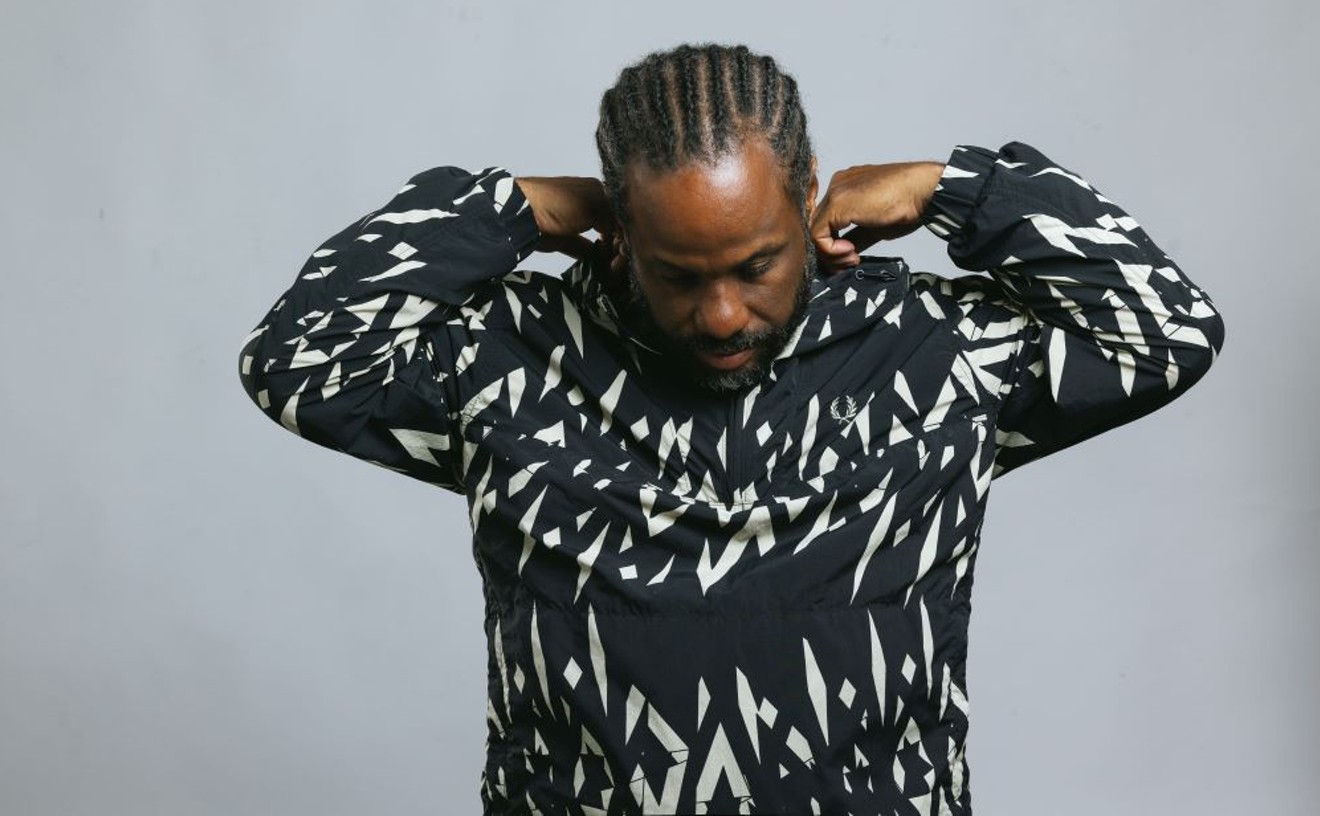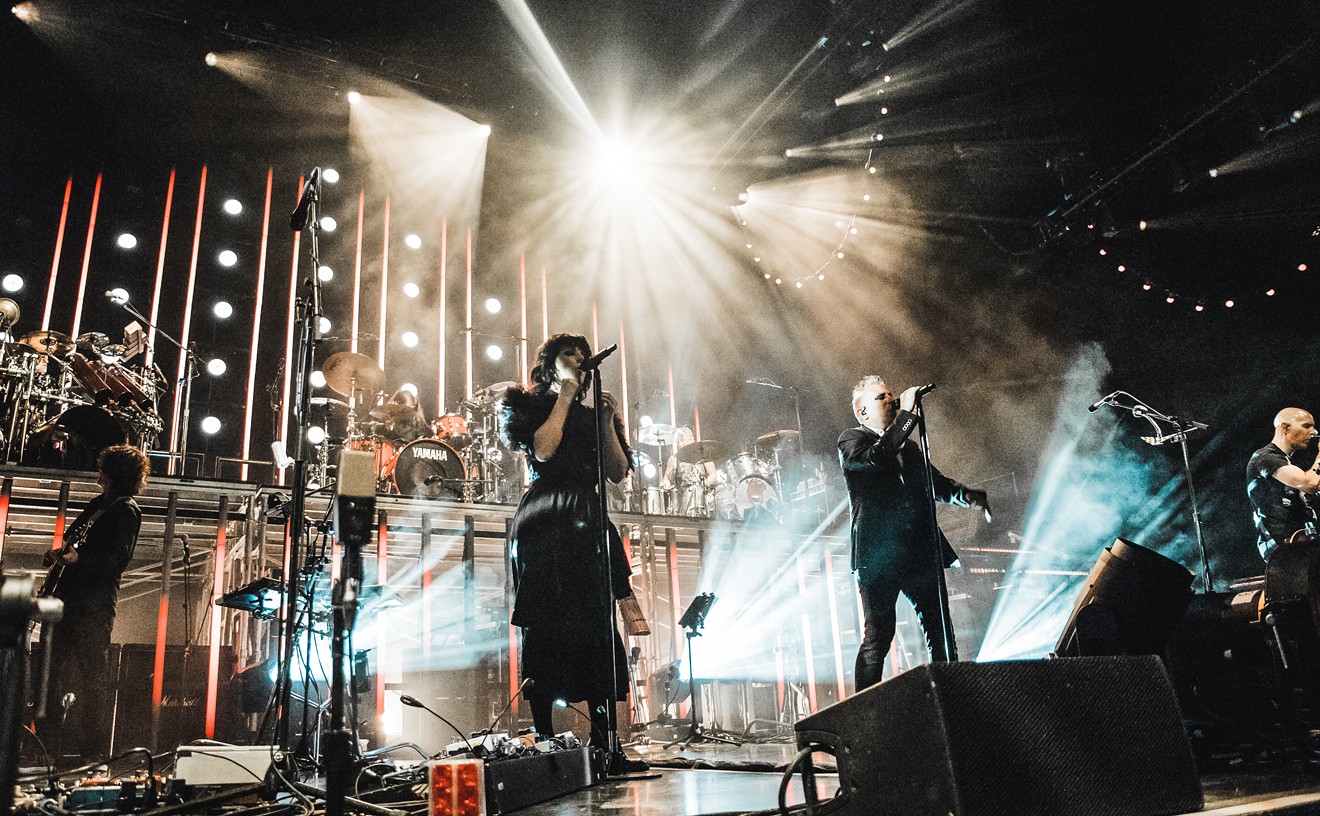If the thought of keeping up with the latest and greatest in underground rock, combing through second-hand record stores until you develop carpal tunnel syndrome, managing the day-to-day operations of a small label, parenting, producing/recording/writing/composing music, reading, writing, living and breathing makes you want to scream enough is enough is enough, then chances are you can't hang with Sonic Youth. That's just an average week for the five (yes, five) real-life adults who make up the veteran rock experimentalists.
Kim Gordon, Thurston Moore, Lee Renaldo, Steve Shelley and, most recently, freelancing hired gun and "fifth member" Jim O'Rourke, have the sort of ephemeral indie cred that eludes even the most ardent scenesters. From December 1999 to summer 2000, the band let loose three releases: the DJ Olive/Ikue Mori/Kim Gordon, the two-CD set of modern composers (Goodbye Twentieth Century) on the band's SYR label and the newest Sonic Youth album proper, Interscope's NYC Ghosts & Flowers. Jane recently ran a story just to check in on rock's über-hip family--Gordon, Moore and their daughter Coco--and their recent move to western Massachusetts. Renaldo's always plying his guitar trade somewhere. Shelley's Smells Like Records has already unleashed three solid albums this year in Christina Rosenvinge, John Wolfington and Fuck. And O'Rourke keeps the sort of schedule that just thinking about could cause a narcoleptic wave to wash over President Bush.
Of course, not everybody thinks the band and its members are all that. Some people try to chide the band--and especially Moore's top-whatever lists, like 1994's "Top Ten From the Free Jazz Underground" that ran in Grand Royal--as playing a crucial role in turning obscure recordings and underground artists into fetishized and highly priced collectibles. Such spleen may have some merit if Moore wasn't so earnestly enthusiastic and supportive of other artists and the music they make. In fact, Moore provided one of the most sincere and educational forms of reverence when he hooked up with writer Byron Coley to compile last year's Jazzactuel boxed set, a compendium of Paris' BYG/Actuel label that released free jazz and avant psychedelia from 1968 to the early 1970s.
"There's this kind of weird reissue label in Europe called Charly, and it's run by one of the guys who was involved with the original BYG label in France," Moore explains. "And he has all the masters [tapes from the original albums]. It's sort of a controversial situation because most of the artists who recorded for [BYG/Actuel] think of him as a kind of a plantation-master thief in a way. But there was somebody working at Charly who realized that they had all these masters and realized the historical importance of this music, and he wanted to do a survey of the label. And he had found out that both Byron and I were sort of aficionados of that music, and of that label in particular, and they contacted us.
"Initially we said we're really not that interested," he admits. "It seemed like another situation where the artists are going to get sort of exploited. And the guy said, 'Well, in a sense I can see where you're coming from, but in another sense, Charly is probably going to reissue this stuff anyway and do a very fly-by-night job on it. All we're asking of you is maybe give it a bit more of a curatorial, historical perspective.' So we decided that well, maybe it would be sort of righteous to do something different--if they're going to release something anyway--and give it the real story of what that label was all about, as much as we can."
Coley and Moore worked on the collection from 1997 to 1999, digging through piles of photos and master tapes. Along the way, they met Jacques Bisceglia, the man who took a number of the photos that grace the Actuel albums, those large, impressive color and B&W images of people like Archie Shepp in a dashiki blowing his tenor in front of a throng of African men with indigenous instruments inside Yasmina, A Black Woman (Actuel 9). What they came up with is a three-CD set containing more than three hours of music from 26 artists. Included are the recognizable names from the imprint--Don Cherry, Sun Ra, Steve Lacy and Shepp--but also some of the lesser-known iconoclasts, such as Dave Burrell, Andrew Cyrille, Grachan Moncur III, Jimmy Lyons, Sunny Murray and Alan Silva, in addition to avant freaks like Daevid Allen, Musica Elettronica Viva, Gong and many, many others.
"We wanted to put together the compilation which gives you a sense of all the music on the label as opposed to just the celebrity names," Moore says. "So we thought it'd be a really good idea to sort of research it and interview some of the people and find out as much about the history of the artists and label as we could and just write about it. So we got a couple of hundred bucks, and we spent about two years doing it."
The accompanying booklet offers the most illuminating account of the time period. It contains moments that are distinctly Coley--only the man who once observed that sometimes "Robert Christgau makes about as much sense as an ass crack full of pennies" could come up with the adjective "ball-shredding" to describe Shepp's languid, lovely "Blasé"--while others are more Moore. He's more in tune with highlighting the sociopolitical context of the time and giving the story the resonant edge that imparts why these recordings are so valuable. The end result is one of the best archives of a time period that the past decade of reissues has produced, up there with Smithsonian Folkways' Harry Smith's Anthology of American Folk Music Vol. I-III and the entire Revenant catalog.
"It was a blast to write," Moore says. "And to do it under the Charly imprint was neither here nor there for us. It's not our concern to take a political stand there. In a way, it came out and people like Sunny Murray and Alan Silva--who I know, to some extent--it just blew their tops. And my whole thing is, they should really get a class-action suit against these guys, all you guys. One thing that they found out is a lot of the publishing on those records--the copyright-controlled publishing for the artists--the guy at BYG changed to BYG publishing, which is sort of criminal. I believe that's sort of their fight now. But at the same time, our whole thing was to bring awareness to the artists in a way that was truthful and not against what they were trying to do."
What some people forget, however, is that you don't just fall into being a musical archaeologist. Nobody is born with an innate ability to sniff out such gems. You have to seek it out and have like-minded friends who point you in the right direction.
Moore was no different. Despite the fact that his much chronicled early days in New York in the 1970s landed him in the company of composer Glenn Branca, where he met Renaldo, his baptism in jazz came a little later. "I got hip to the free scene just by being turned on to the urban jazz of John Coltrane and Charles Mingus, the sort of '60s, modal jazz," Moore says. "Kim was always sort of very aware of that music growing up. She grew up in L.A., and her father was hip to 1950s and '60s jazz. I think I became interested in it mostly because of the Minutemen and the SST label. The Minutemen referenced the jazz thing. I was curious about that. And I really loved what was happening at that label in the early and mid-'80s. They sort of looked at jazz as something that was very radical. Also knowing that Tom Verlaine in Television--I remember reading an interview with him in the '70s and he was talking about Albert Ayler. And I remember seeing that [Impulse! 1967] Albert Ayler in Greenwich Village record in [NYC record shop] Bleeker Bob's as a teen-ager, and it had this weird, psychedelic cover. I was really enamored by it, but I didn't know anything about his music or his context historically. And then being really into no wave music in New York and the Contortions. James Chance was of course referencing free jazz."
Free jazz and what it represented--a freedom of thought as well as musical strictures--always seemed to be percolating around Moore in some way. "So there were always little signifiers," Moore says. "But I didn't really sort of follow through on it until sometime in the mid-'80s, and I started playing some of Kim's old Coltrane records that she had at her parents' house. And it was really alien to me because they were these extended compositions that would go in unexpected directions. About the same time I got to know Byron, and I knew he was a collector of sorts. And we were going on tour so I asked him to make me a tape of some things to give me the historical sense of things, and he made me like 18 tapes. And so there was this whole summer of touring where I sort of jammed on these tapes. And it started to take me into those things that were very, very far out."
Soon he started reading LeRoi Jones' Black Music and drank deep of Jones' chronicles of NYC's coffee shop and loft scene. The Knitting Factory opened up on Houston Street in New York, providing many of these artists with a place to play. John Zorn and his group of free improvisers held court there often. And Moore was one of the blossoming fans who regularly attended the frenzies.
"It was all very fortuitous," Moore recalls. "There were a small group of people about my age who were also going, but to the jazz guys we were sort of outsiders. Because at the time who listened to those [1970s free jazz] records? Other jazz musicians listened to those records and that's about it. There were magazines that I've seen from that era that talked about the recordings of the time. But there were no such things as fax machines or e-mail, so there was no way to get the word out [to people] outside in immediate, insular community."
In a way, 20 years into its career, Sonic Youth occupies a similar historical terrain as those free-jazz elder statesmen when Moore first encountered them. After 11 albums and a small library of EPs, seven-inches, solo releases and side projects, Sonic Youth has not only survived the alternative music shopping spree of the early 1990s but emerged untarnished by mainstream cynicism. (Think about it: Dave Markey's film about the Sonic Youth and Nirvana European tour, 1991: The Year Punk Broke, is a decade old, and if you watch it again it looks like a faded snapshot of another time and place.) Name other bands that formed in the late '70s and early '80s that are still doing their thing in a vibrant, relevant way outside of the commercial channels of the music-industry Leviathan. It's a pretty short fucking list.
More interestingly, Sonic Youth has become part of a subculture that is becoming as much a hard-to-contextualize period as the free scene Moore and Coley researched for Jazzactuel. Most of the bands from SY's early days are no longer around, and as Joey Ramone's recent passing at the age of 49 reminds us, some players may no longer be of this earth. Outside of the "celebrity" names of no wave--DNA, Teenage Jesus and the Jerks, Mars, the Contortions, UT--it's virtually impossible to locate recordings from any of the other acts from the era. It's a time that is also slowly dissipating into the memories of the people who were there.
But musical history does like to repeat itself in new forms. The political fire of free jazz in the '60s and '70s is being rekindled in a new, street savvy lingua franca of rap and hip-hop (see Mos Def, the Roots). And you can make the argument that the whole idea of post-rock--as a musician-led alternative to the alternative sold as the music of today's generations--is a nexus to American post-punk that inaugurated the Reagan years. In effect, Sonic Youth has become a part of a history of America's underground musical landscape even as it continues to push forward.
"It's funny, because as participants at the time, you aren't really aware of creating anything of historical value," Moore says. "But you sort of see the activity in retrospect as an activity of documentation, of capturing what was going on. And so it's great to see younger people take an interest in those things, like no wave. And since I've always been into the sort of archival aspect of records, to be part of it on both sides--as a writer and observer and having a historical interest in it--it has been an absolute joy. Some musicians and record collectors I've met who have an interest in it have often been fairly aloof about the historical value and social aspects of it."
It's an endeavor that has been difficult. When punk proverbially broke in 1991, underground music was catapulted to the fore for a brief romance with success. As the tides of pop culture waned, it was left behind for the next new thing. But it's slowly bubbling back into view.
"The whole thing with being able to reissue things on CD and having that whole market now has been completely instrumental in reintroducing the underground into mainstream marketplaces and information circles," Moore says. "I think the more sort of controlled mainstream information became the more sort of important documentation of the underground. Things like fanzines and the Internet have demonstrated a sizable interest in it. The mainstreaming of the alternative in the 1990s became so widespread that I think people want alternatives to the alternative. It's ironic, in a way, because the whole sort of youth culture that's being offered as mainstream, in the 1960s it was hip and the adults were square. We've sort of seen a turnaround. I mean, adult culture has always been square, but we live in a time when it's the youth culture that's square."
One of the main ways Sonic Youth has avoided being absorbed by the mainstream is that it infuses its musical precipitates with ideas that aren't explicitly musical, creating statements that are distinctly its own and of its time yet aware of the past and other aspects of the present. The band has always displayed a keen interest in contemporary visual art with its album covers, whether it be Gerhard Richter (Daydream Nation), Rita Ackerman (Moore's Psychic Hearts), Mike Kelley (Dirty), William Burroughs (NYC Ghosts & Flowers) or Marnie Weber (A Thousand Leaves). Even American writers get nods. A Thousand Leaves is a sleight-of-hand allusion to Whitman's Leaves of Grass. And NYC Ghosts & Flowers draws a creative line from the Beat sense of 1950s NYC to the flower-power children of the 1960s and Ayler, whose 1964 ESP debut, Spiritual Unity, opened with the soul cry "Ghosts: First Variation."
"That was always the original intention, to combine art and literature and music, and it always has been," Moore says. "Most of the people involved in the no wave scene were coming out of an art background. That was one of the original reasons why I moved to New York. Of course, I wanted to play punk rock and open up for the Ramones, but I also wanted to be surrounded by New York's creative energy. So we always wanted that to be part of what we do and not sort of hide it. That's something I always admired about modern composers like John Cage, whose work was often informed by or established a dialogue with things going on in other areas, like visual art or dance. I definitely don't think it's a model for all musicians to follow, but it's part of what we do."
They'll be doing it in various ways over the next six months. May finds the band doing weekend jaunts--like the one that brings the band to Dallas and Austin. In June the band travels to Europe to do a series of concerts of the material featured on its Goodbye Twentieth Century double CD, where it will be joined by percussionist William Winant. Then the band will begin working with French director Olivier Assayas on a soundtrack for his latest movie. And in the fall the band is curating the first American edition of the All Tomorrow's Parties music festival in Los Angeles.
Even with such a busy schedule, however, Moore makes time to discover new artists--or at least those who are new to him. "I've been really getting into reading a lot about Ted Barrigan recently," Moore says. "He was this writer from the 1960s and 1970s. When I first moved here, I remember this big, cigarette-smoking guy with this coterie of young people that always hung out when he was talking. I knew he was somebody that was always around, but I didn't know who this freak was, and I later found out he was Ted Barrigan. He died in 1983, and just recently I've really become interested in his work. He was really connected to the sort of downtown culture of the '60s. He had a really interesting take on everything, and he was a guy that Andy Warhol liked early on, always on the fringe. There's not that much historical information on him, but I've been reading memoirs by other people about him. He was a guy who did some of those really underground, mimeograph zines of writing and stuff, like with [Peace Eye Bookstore owner, writer-poet and Fugs member] Ed Sanders. But as far as music is concerned, I don't know. I listen to a little bit of everything."










